Chapter 9 Common Machines Review Questions Environment Review Questions MCQs
Question 1. Something that makes a job easier ________________.
- A machine
- A simple machine
- A compound machine
- A work
Answer: 1. A machine
Question 2. A combination of simple machines is known as ________________.
- A machine
- A simple machine
- A compound machine
- A work
Answer: 3. A compound machine
Read And Learn More: WBBSE Solutions For Class 6 School Science
Question 3. Something that converts one kind of movement to another is ________________.
- A machine
- A simple machine
- A compound machine
- A work
Answer: 1. A machine
Question 4. How many simple machines are there?
- Four
- Five
- Six
- Seven
Answer: 3. Six
Question 5. Which of the following is not considered a simple machine?
- Wedge
- Pulley
- Lever
- Bicycle
Answer: 4. Bicycle
Question 6. Which is an example of someone using a simple machine to do work?
- A boy walking along the footpath
- A girl eats a sandwich
- A mother pushing a drum up a ramp into a building
- A father reading a newspaper
Answer: 3. A mother pushing a drum up a ramp into a building
Question 7. The mechanical advantage of a machine is the number of times a machine increases
- The distance an object is moved
- The height to which the object is raised
- The change in direction
- The force exerted on the machine
Answer: 4. The force exerted on the machine
Question 8. How can a cricket bat be considered a machine?
- It multiplies force
- It multiplies distance
- Both 1 and 2
- It acts as a wedge
Answer: 3. Both 1 and 2
Question 9. Most of the machines in a human body consisting of bones and muscles are called ________________.
- Wedges
- Levers
- Pulley
- Complex machines
Answer: 2. Levers
Question 10. Which is not a type of simple machine?
- Spring
- Screw
- Pulley
- Wedge
Answer: 1. Spring
Question 11. One example of a complex machine is a ________________.
- Door
- Pliers
- Scissors
- Shovel
Answer: 3. Scissors
WBBSE Class 6 Simple Machines MCQs
Question 12. The fixed point that a lever pivots around are called the ________________.
- Axle
- Pulley
- Gear
- Fulcrum
Answer: 4. Fulcrum
Question 13. Which body part acts as the fulcrum of levers?
- Muscles
- Bones
- Joints
- Tendons
Answer: 3. Joints
Question 14. A wheelbarrow is an example of a ________________ class lever.
- Fourth
- Third
- Second
- First
Answer: 3. Second
Question 15. Which part of the lever supplies the force to move something?
- Load
- Fulcrum
- Effort
- Axle
Answer: 3. Effort
Question 16.
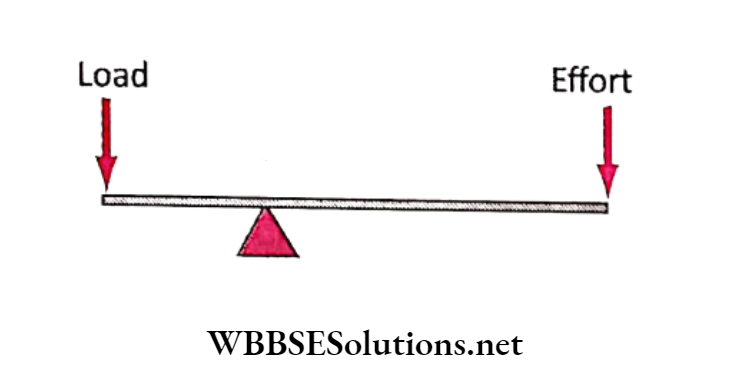
- The above figure is an example of
- Complex machine
- Lever
- Screw Inclined plane
Answer: 2. Complex machine
Question 17. In the above figure which of the following statements is true?
- AB is the effort arm and BC is the load arm
- AC is the effort arm and BC is the load arm
- BC is the effort arm and AC is the load arm
- BC is the effort arm and AB is the load arm
Answer: 4. BC is the effort arm and AB is the load arm
Question 18. Which of these is an example of a third-class lever?
- Scissors
- Fishing pole
- Pliers
- Nutcracker
Answer: 2. Fishing pole
Practice MCQs on Work and Energy in Machines
Question 19. A simple lever has
- One load and load-bearing arm
- One load arm and an effort arm
- One effort arm and a fulcrum
- One load arm, one effort arm, and a fulcrum
Answer: 4. One load arm, one effort arm, and a fulcrum
Question 20. Which of the following machines does not have a fulcrum?
- Inclined plane
- Nutcracker
- Scissors
- Spade
Answer: 1. Inclined plane
Question 21. Which is not a double lever among the following
- Nail clipper
- Spoon
- Nutcracker
- Scissors
Answer: 2. Spoon
Question 22.
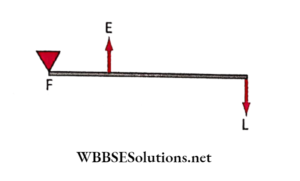
The above figure is a class lever.
- First
- Second
- Third
- Complex
Answer: 3. Third
Question 23. The wedge, screw, and lever are all
- Simple machines
- Complex machines OF
- Found in the human body
- None of this eval bris
Answer: 1. Simple machines
Question 24. Study the pictures below. In which case does the effort move through a shorter distance than the load?
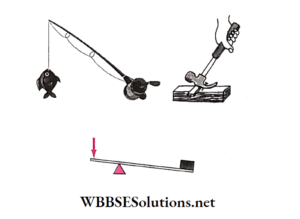
- An only
- C only
- A and C only
- B only
Answer: 3. A and C only
Question 25. If the mechanical advantage of a simple machine is 3, then
- The output force is 3 times the effort
- The effort is 3 times the output force
- The work output is 3 times the work input
- None of the above
Answer: 1. Output force is 3 times the effort
Question 26. A porter prefers to lift a load on the deck of a truck with a ________________.
- Lever
- Wheel
- Pulley
- Inclined plane
Answer: 4. Inclined plane
Question 27. Modern luggage is easy to handle because it is fitted with ________________.
- Pulleys
- Axle
- Wheels and long handle
- Screws
Answer: 3. Wheels and long handle
Question 28. Which of the following machines has a fulcrum at its one end?
- A pair of scissors
- A nutcracker
- A pair of tongs
- Both 2 and 3
Answer: 4. Both 2 and 3
Question 29. Which simple machine does a flagpole make use of?
- Screw
- Inclined plane
- Pulley
- Lever
Answer: 3. Pulley
Question 30. The wedge may be used to ________________.
- B balance a plank
- Join two planks
- Lift a plank
- Split a plank
Answer: 4. Split a plank
Common MCQs on Mechanical Advantage
Question 31. What are two examples of an inclined plane?
- Screw and wedge
- Lever and screw
- Edge and lever
- Wheel and axle
Answer: 1. Screw and wedge
Question 32. A wheel with a groove in its rim in which to place a rope is a ________________.
- Screw
- Pulley
- Fulcrum
- Lever
Answer: 2. Pulley
Question 33. A ________________ is a simple machine used to hold two objects together.
- Pulley
- Lever
- Screw
- Inclined plane
Answer: 4. Inclined plane
Question 34. Which simple machine would stairs be an example of?
- A wedge
- A lever
- A pulley
- An inclined plane
Answer: 4. An inclined plane
Question 35. Which of these is an example of a wedge?
- A skateboard
- A broom
- Stairs
- A butter knife
Answer: 3. Stairs
Question 36. A screw is made up of ________________ wrapped around a rod.
- Treads
- Springs
- Threads
- Strings
Answer: 3. Threads
Question 37. Which type of simple machine would be found on the bottom of a wagon?
- Pulley
- Screw
- Wedge
- Wheel and axle
Answer: 4. Wheel and axle
Question 38. The mechanical advantage of an incline depends on the ________________.
- Mass of the incline
- The slope of the incline
- Height of the incline
- Length of the incline
Answer: 2. Slope of the incline
Question 39. Rust prevention in machine parts can be done by
- Cleaning only
- Lubrication only
- Cleaning followed by proper painting
- None of the above
Answer: 3. Cleaning followed by proper painting
Question 40. When a screw is turned once around, it advances a distance equal to the ________________.
- Pitch
- Diameter of the screw head
- Load arm
- Effort arm
Answer: 1. Pitch
Question 41. The human forearm works as
- First-class lever
- Second class lever
- Third class lever
- A combination of all
Answer: 3. Third-class lever
Question 42. A zipper of a bag is a
- Pulley
- Wedge
- Screw
- Wheel and axle
Answer: 2. Wedge
Question 43. The oar of a boat is an example of a
- First-class lever
- Second class lever
- Third class lever
- None of the above
Answer: 2. Second-class lever
Chapter 9 Common Machines Fill In The Blanks
Question 1. To open the lid of a can a spoon acts as a __________.
Answer: Lever
Question 2. The fulcrum of the spade is situated at its __________.
Answer: Far end of the handle
Question 3. The arm that extends from the fulcrum to the point of application of effort is known as the __________
Answer: Effort arm
Question 4. In __________ class lever the fulcrum is placed between the load and the effort.
Answer: First
Question 5. A roller skate could be an example of __________.
Answer: Wheel and axle
Question 6. A machine that utilizes two or more simple machines is called a __________.
Answer: Complex machine
Question 7. A ramp in a parking garage is an example of __________.
Answer: Inclined plane
Question 8. A chef sometimes holds the tip of a knife stationary when chopping food. Held this way, the knife is a complex machine made up of a wedge and a __________.
Answer: Second-class lever
Question 9. Lengthening a ramp will __________ its mechanical advantage.
Answer: Increase
Question 10. As you bite an apple, your front teeth act as a simple machine called a __________.
Answer: Wedge
Question 11. Using energy a machine can change the amount, speed, or __________ of a force to perform an intended action.
Answer: Direction
Question 12. Leverage depends on __________ of the lever.
Answer: Length
Question 13. A __________ pulley is a combination of fixed and movable pulleys.
Answer: Compound
Question 14. An __________ is a rod centered in the wheel.
Answer: Axle
Question 15. The angle of incline is an __________ angle.
Answer: Acute
Question 16. Machines may be employed in __________ environment where it is difficult for a man to work.
Answer: Hazardous
Question 17. A regular __________ after every use can increase the longevity and performance of a machine.
Answer: Cleaning
Question 18. A jar lid is a type of simple machine called __________.
Answer: Screw
Question 19. A wedge has two __________. which meet at a sharp edge.
Answer: Inclined planes
Question 20. A __________ pulley remains fastened to the load itself.
Answer: Movable
Question 21. A lever has a fulcrum and load at the two ends.
Answer: Third class
Question 22. Gears are a form of __________.
Answer: Wheel and axle
Question 23. The distance between two neighboring __________ of a screw is called its pitch.
Answer: Threads
Question 24. There are __________ classes of levers.
Answer: Three
Question 25. A twisted inclined plane wrapped around a rod or pole is a __________.
Answer: Screw
Chapter 9 Common Machines Identify As True Or False
Question 1. A washing machine is a simple machine.
Answer: False
Question 2. Pulley changes the direction of the applied force.
Answer: True
Question 3. Less effort is used to climb a steep inclined plane.
Answer: False
Question 4. In the first class lever, the load is in the center.
Answer: False
Question 5. A nail holds things more firmly than a screw.
Answer: False
Question 6. It is easier to get a screw with a bigger pitch into a piece of wood than a screw with a smaller pitch.
Answer: False
Question 7. Both wheel and axle have a common axis of rotation.
Answer: True
Question 8. An inclined plane reduces the amount of work done compared to pulling something straight up.
Answer: False
Question 9. The axle is a smaller wheel fastened to the wheel at its center.
Answer: True
Question 10. The human arm works as a third-class lever.
Answer: True
Question 11. Using more than one pulley at a time, we get more advantages.
Answer: True
Question 12. There can be levers without a fulcrum.
Answer: False
Question 13. A pair of scissors work as a single lever.
Answer: True
Question 14. The lid of the laptop is connected to the keyboard by a lever.
Answer: True
Question 15. The deployment of machines has led to advantages only in the history of mankind.
Answer: False
Question 16. Complex machines are the building blocks of simple machines.
Answer: False
Question 17. How much load the effort can lift, depends on how many times the wheel is larger than the axle.
Answer: True
Question 18. A leaning ladder is an example of an inclined plane.
Answer: True
Question 19. Pulleys are employed in window blinds.
Answer: True
Question 20. The mechanical advantage of all classes of the lever is the same.
Answer: False
Question 21. In the second class lever, the effort arm is always longer than the load arm.
Answer: True
Question 22. Machines undergo wear and tear as they are put to use on a regular basis.
Answer: True
Question 23. A pulley does not have an axle.
Answer: False
Question 24. Machines reduce the amount of work needed to do a job.
Answer: False
Question 25. To lift a huge block of stone through a certain height, one should choose a crowbar.
Answer: False
Question 26. Decreasing the slant of an inclined plane increases its mechanical advantage.
Answer: True
Question 27. While a screwdriver is used to insert a screw, it acts as a wheel and axle.
Answer: True
Question 28. Machines employ moving parts only.
Answer: False
Question 29. Wheel, axle, and rope or chain make a pulley.
Answer: True
Question 30. When you raise your leg, the knee acts as a fulcrum for the upper leg.
Answer: False
Chapter 9 Common Machines Match The Columns

Answer: A-3,B-2,C-1
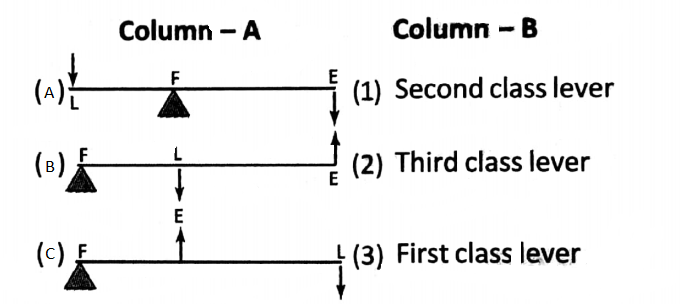
Answer: A-3,B-1,C-2
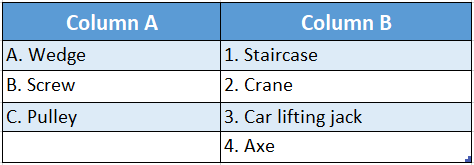
Answer: A-4,B-3,C-2
Chapter 9 Common Machines Answer In Words Or A Sentence
Question 1. What sort of angle an inclined plane makes with the ground?
Answer: An acute angle with the ground.
Question 2. Who invented simple machines?
Answer: The Greek philosopher Archimedes.
Question 3. In which class of lever is the direction of the input force opposite to the direction of the output force?
Answer: First class lever.
Question 4. Give three examples of complex machines commonly found in the kitchen.
Answer: A toaster, mixer-grinder, and microwave oven.
Question 5. What type of machine is a pencil sharpener?
Answer: Wheel and axle.
Question 6. Which simple machine turns a Ferris wheel?
Answer: Wheel and axle.
Question 7. A screw is actually another simple machine. Which one?
Answer: Inclined plane.
Question 8. Mention one similarity between second-class and third-class levers.
Answer: Both have a fulcrum at one end.
Question 9. You want to raise a load by using a pulley. In which direction should your pull be to raise it?
Answer: Directed downward.
Question 10. The diagram below shows a crowbar. Calculate the length of the effort arm.
Answer:
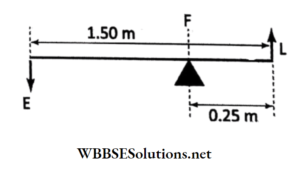
EF=(1.50-O.25)m=1.25m
Question 11. How does the advantage of using an inclined plane increase?
Answer: The advantage associated with an inclined plane increases as the length of the inclined edge increases compared to its height making the angle of incline or the slope lesser and lesser.
Question 12. Mention the name of a simple machine that is used by your mother while cooking in the kitchen.
Answer: Tongs.
Question 13. Find out the odd one Screw, ladder, electric vibrator, pulley.
Answer: Electric vibrator: It is a complex machine but others are simple machines.
Question 14. Mention the name of a human body part that acts as a wedge.
Answer: Teeth When we eat, we put our bottom teeth into the middle of the food and break it apart with our top teeth.
Question 15. Mention the name of a part of a bicycle that acts as a simple machine.
Answer: Pedals, back wheel and axle (wheel and axle), or Pedals and chain (Pulley).
Question 16. What is to be applied to a machine to minimize the damage caused by sliding friction between its moving parts?
Answer: Lubricating oil or grease.
Chapter 9 Common Machines Short Answer Type Questions
Question 1. Pens are class-3 levers-justify.
Answer: Pens are class-3 levers since by pivoting them on our hands and holding them in the middle, we get much more control over the nib or the ballpoint.
Question 2. Mention certain disadvantages associated with the use of machines.
Answer: The disadvantages that are associated with the use of machines may be loss of human skill, over-dependence, monotony, destruction, etc.
Question 3. How does the location of the fulcrum influence the working of a lever?
Answer: The closer the fulcrum is to the load being lifted (meaning a shorter load arm compared to an effort arm), the higher shall be the load that the person can lift.
Thus the location of the fulcrum actually influences the mechanical advantage of a lever.
Question 4. What is the purpose of lubrication?
Answer: Movable parts of the machine undergo extensive wear and tear, especially on the surfaces which come in contact while the machine runs.
This leads to the generation of heat. Lubrication cools the parts, makes movements easy, and reduces wear and tear.
Question 5. Why is a screw called a twisted inclined plane?
Answer: The sharp spiral ridges on the body of a screw make an inclined plane. It allows movement from a lower to a higher position but at the same time, it moves in a circle.
Question 6. What is a compound pulley?
Answer: A compound pulley consists of a combination of fixed and movable pulleys.
Question 7. What type of simple machine can you find on the floor of a bathtub?
Answer: The floor of a bathtub slopes towards the drain. This allows water to flow out with the force of gravity. Hence it acts as an inclined plane.
Question 8. Explain the action of the pulley used on flag-poles.
Answer: A fixed pulley is used on flagpoles. The flag is tied to a rope that goes around the pulley. The pulley remains fixed to the top of the flag pole.
By pulling the other end of the rope downwards, the flag is raised.
Short Answers on Types of Simple Machines
Question 9. When we bite with our front teeth, our jaw acts as a third-class lever. As we chew with our back teeth, our jaw acts as a second-class lever. Explain how our jaw can act as two different classes of levers.
Answer: The fulcrum of our jaw is located slightly below and in front of our ears. The input force is at the side of the cheek. When we bite, the output force is located in front of the mouth.
The output distance is greater than the input distance. Thus the jaw acts as a third-class lever. When chewing, the output force is near the back of the jaw and the input distance is greater than the output distance.
Hence now the jaw acts as a second-class lever. As a second-class lever, the jaw multiplies force, allowing us to chew and grind food more easily.
Question 10. Why roads on the hills are made winding?
Answer: A road up a hill is an inclined plane. An inclined plane makes work easier along a gradual slope. Hence it becomes easier to ascend a hill on a zigzag road than on a steep road.
The length of the incline or slant length of a zigzag road is more in length compared to a steep road of the same height. Thus the mechanical advantage of a zigzag road is more than that of a steep road.
Question 11. In the following pulley systems, identify the fixed pulleys.
Answer:
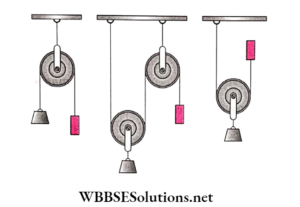
Out of the four pulleys shown, pulleys A and C are fastened to the ceiling by means of hooks. Hence these are fixed pulleys.
Question 12. A lever is working as shown in Figure.
What would happen to the mechanical advantage of the lever if the load was moved farther from the fulcrum?
Answer:
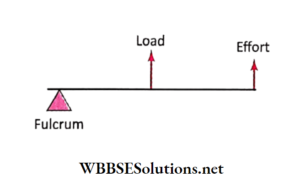
If the load was moved farther from the fulcrum, the length of the load arm increased whereas the effort arm remains the same as before. Hence the mechanical advantage of the lever would decrease.
Question 13. Define the fulcrum.
Answer: The point on the lever that does not move while the lever does the work is called the fulcrum (F). Hence it acts as a fixed point of support for the lever.
Question 14. Explain why wedges and screws are actually
Answer: types of inclined plains. A wedge is shaped like a double-inclined plane meeting at a sharp edge. A screw is an inclined plane wrapped around a cylinder to form a spiral.
Like an inclined plane, the wedge and the screw multiply the input force by having it move a greater distance along a sloping edge.
Question 15. Give two examples of a wedge being used in day-to-day life.
Answer: Kitchen knives and razor blades are examples of wedges being used in day-to-day life.
Question 16. In a lever, if the load is moved farther from its fulcrum, how is the effort going to change to lift the load?
Answer: In a lever, if the load is moved farther from the fulcrum, the length of the load arm increases. Thus to lift the same load, the effort shall need to be increased since the effort arm remains the same as before.
Question 17. Explain the actions of the following as levers
1. a fishing rod
2. a nutcracker
3. a spade.
Answer: 1. A fishing rod has a load and the fulcrum on either side of the effort as shown. Hence it acts as a third-class lever.
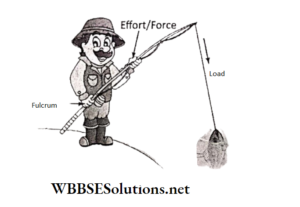
2. A nutcracker has a fulcrum at one end, effort or force applied at the other end 50 and the force is produced in the middle of the lever. Hence the load is placed between the ep fulcrum and effort. Thus it acts as a second-class lever.
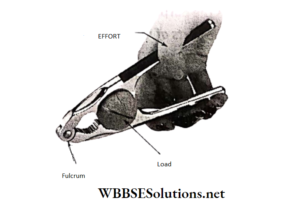
3. A spade is held at the far end which therefore acts as the fulcrum. Effort is given at the center of the handle with the other hand. The blade of the spade works as the load. Thus it acts as a third-class lever.
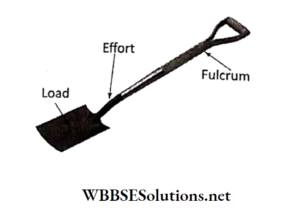
Question 18. Why is it easier to fix planks using screws rather than nails?
Answer: The sharp spiral-edged ridges on the body of a screw act to hold the planks together.
Nails do not have sharp ridges and so, there is a possibility of slippage under a severe blow in some circumstances leading to separation of the component members. Hence screws are preferred over nails in carpentry.
Question 19. Why is a staircase made like an incline?
Answer: An inclined plane makes work easier when somebody needs to go from a lower place to a higher place.
It actually extends the distance to be traveled horizontally in order to achieve the desired elevation change or rise.
Thus the 913 effort needed as input force becomes smaller for a person while climbing up the stairs. SageIt is worthwhile to mention here that it is easier sv to climb up the stairs if the slope of the incline is less.
Hence, in a house where elderly people reside, the staircase is to be built with less slope or it should be less steep.
Question 20. How is the mechanical advantage of a complex machine determined?
Answer: The mechanical advantage of a complex noho machine is just the product of the mechanical advantages of the simple machines of which it is composed.
Let a complex machine be built with a lever and a pulley with mechanical advantages of 3 and 2 respectively. So the mechanical advantage of the complex machine, so built, shall be 3×2 or 6.
Question 21. Place the correct word in place of? in the figure. Give one example.
Answer: ?= Inclined surface or slant surface.
Example: Wheelchair ramp or slides for children in the playground.
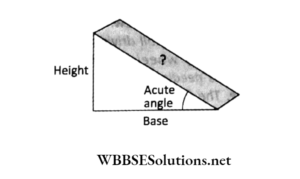
Question 22. Write two differences between simple and complex machines.
Answer:
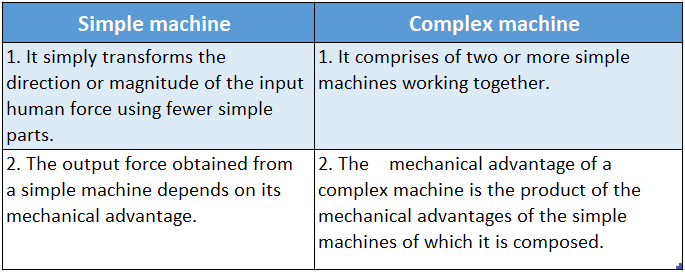
23. Give two examples of inclined planes as found in our home.
Answer:
1. Ramp in the main gate/door
2. Stairs or
3. Slanted roof
Chapter 9 Common Machines Long Answer Type Questions
Question 1. Discuss some of the utilities of using machines.
Answer:
Utilities Of Machine
We cited quite a few examples of machines in the previous section. All these machines have one thing in common when you apply a force to them, they increase their size and apply a greater force somewhere else.
You can’t cut meat with your hand alone, but if you push down on a knife, the long handle and the sharpened blade magnify the force you apply with your hand, and the meat slices effortlessly.
When you pound a nail with a hammer, the handle increases the force you apply.
And because the head of the hammer is bigger than the head of the nail, the force you apply is exerted over a smaller area with much greater pressure and the nail easily enters the wood.
Try pushing in a nail with your finger and you’ll appreciate the advantage a hammer gives you.
Living in a world without machines is now almost impossible to imagine. Without even the simplest machines, many tasks that we do every day would be almost impossible.
Machines make it easier for humans to perform everything from the simplest to the most complicated of tasks.
A washing machine, for instance, saves a lot of time as we can do other things while the clothes are being washed.
Vacuum cleaners save a lot of time and energy in cleaning the floors or carpets. A sewing machine is also a very useful machine. Sewing by hand is a very slow job requiring a lot of patience.
Using a sewing machine helps to stitch clothes quickly and neatly. Let us now learn about the advantages of the use of machines.
Question 2. What is a simple machine? How many types of simple machines are there? Name them.
Answer:
The following are the advantages of the use of machines :
1. Use of natural forces:
Machines have made it possible to harness the forces of nature in
Simple machine:
in earlier times when a human being needed to move something heavy, he or she probably picked up a long stick, stuck it under the edge of the heavy object and stuck it under the edge of the heavy object, and then pushed it down on the other end of the stick.
The service of man. Man can fly in airplanes, he can connect continents in seconds, and electricity can be generated from sunrays, waterfalls, winds, etc. All these have been made possible with the aid of machines.
2. Heavy and delicate work made simple :
Tasks that are too heavy or too delicate for human muscles to do can be done easily by a machine. A crane can lift loads beyond the human capacity. Without the aid of machines, such jobs would not have been done.
3. Faster and more accurate work :
Only machines are capable of mass production, that too accurately, without a break and for a continuous duration.
While man can make only a few articles in a day by himself, machines employed in factories can make thousands per day for years together with extreme accuracy.
A human being, for example, can not paint exactly the same picture twice. But a machine can turn out thousands of identical articles. This has also resulted in the availability of durable articles at a much cheaper price.
4. More employment:
The introduction of machines in the modern society has created many new occupations. It has thus widened the scope of employment.
5. Hazardous work environment:
Human beings are relieved of all disagreeable and unpleasant jobs in hazardous environments by suitably deploying machines to do the same.
However, it must be remembered that machines are also associated with certain evils. These may be loss of human skill, over-dependence, monotony, destruction, and so on.
Examples of Real-Life Applications of Simple Machines
Question 3. Define lever. What is meant by First class, Second class, and Third class levers? Explain with diagrams.
Answer:
Idea of Lever
Levers were probably the first machines used by human beings. It is a long tool such as a pole or a rod put under an object to lift it.
Levers are all around us. The handle of the spoon is a lever since it makes it easier for us to open the lid of a can. The lever becomes more efficient when combined with a fulcrum.
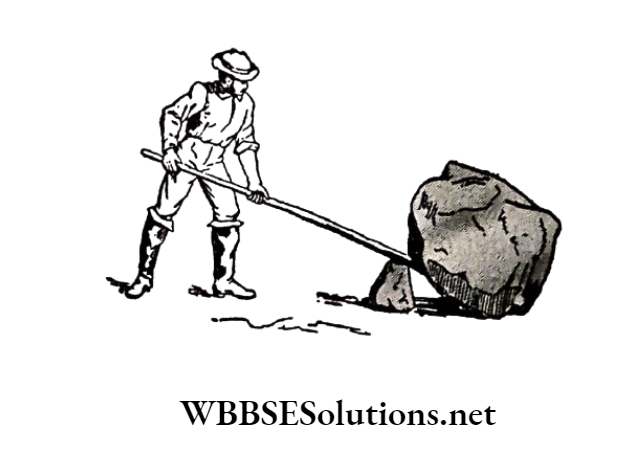
The fulcrum is another object, maybe a rock, used to give alginate Lana to tone support or brace under the long tool. This gives the long pole something to push down against.
Let us take another example to get the matter clear. When you sit on a see-saw, you have probably found out that you need to sit further from the balance point if the person at the opposite end is heavier than you.
The balance or pivot point acts as the fulcrum here. The further away from the fulcrum you sit, the more you can multiply the force of your weight.
If you sit a long way from the fulcrum, you can even easily lift a much heavier person sitting at the other end provided of course they sit very close to the fulcrum on their side.
The force you apply with your weight is called the effort. The fulcrum produces a bigger force to lift the load (here it is the weight of the other person).
The words “effort” and “load” are associated with the working of the lever. However, the important thing fo to remember about levers is that the force you produce (which drives the load) is bigger than the force you apply as effort.
Some examples of levers are:
Door handles the claws of a hammer (for removing nails), light switches, bottle openers, tongs, knives, screwdrivers, wrenches, scissors, and hinges.
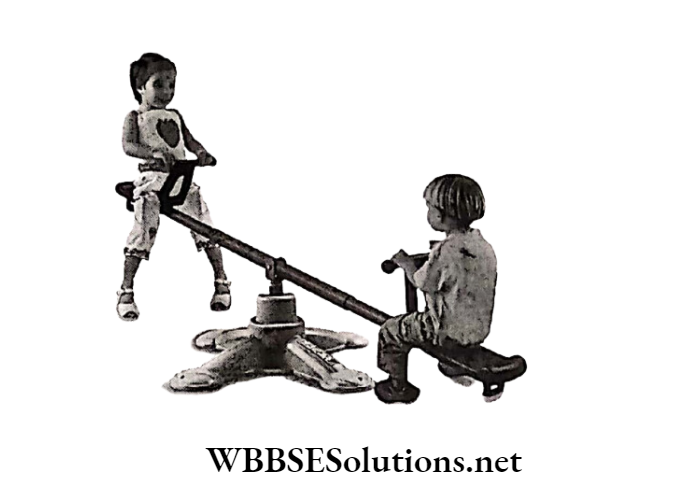

The force that is used on the lever is called the effort (E).
The weight that is moved or lifted by the lever is called the load (L).
The point on the lever that does not move while the lever does the work is called the fulcrum (F). Hence it acts as a fixed point of support for the lever.
Classes of Lever
All levers give leverage, but not all of them work the same way. There are actually three different kinds of levers (sometimes known as classes).
The class of a lever depends on the relative positions of the efforts, load, and fulcrum.
First-class or Class-1 levers
In a First class lever, the effort or force we apply is on the opposite side of the fulcrum to the force the lever produces.
Hence the fulcrum is placed between the effort and the load. See-saw, beam balance, and scissors are all first-class levers.
Hence the load is placed between the fulcrum and the effort. Nutcrackers, bottle openers,s, and wheelbarrows are all examples of Second class levers.
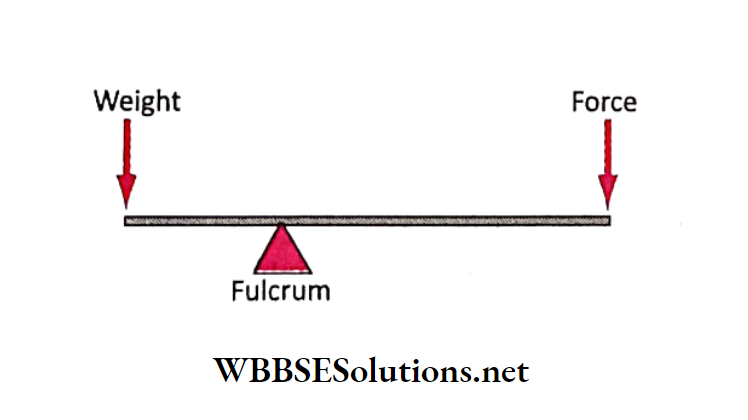
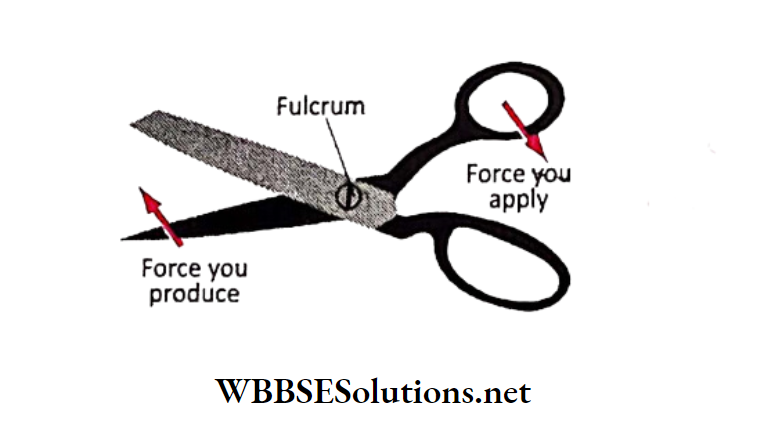
Second-class or Class-2 levers
A Second class lever is arranged in a different way, with the fulcrum at one end. The effort or force is applied at the other end and the force is produced in the middle of the level.
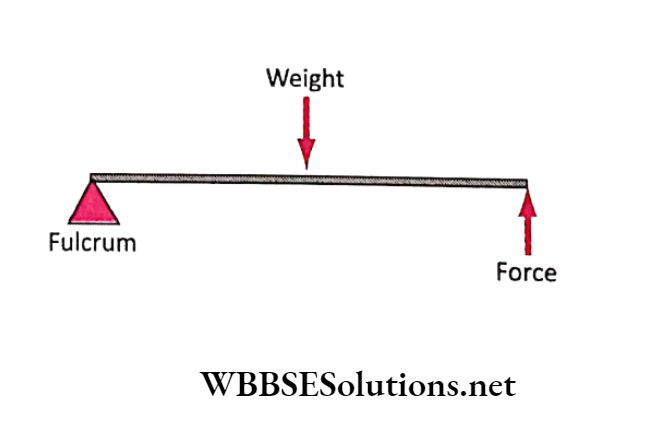
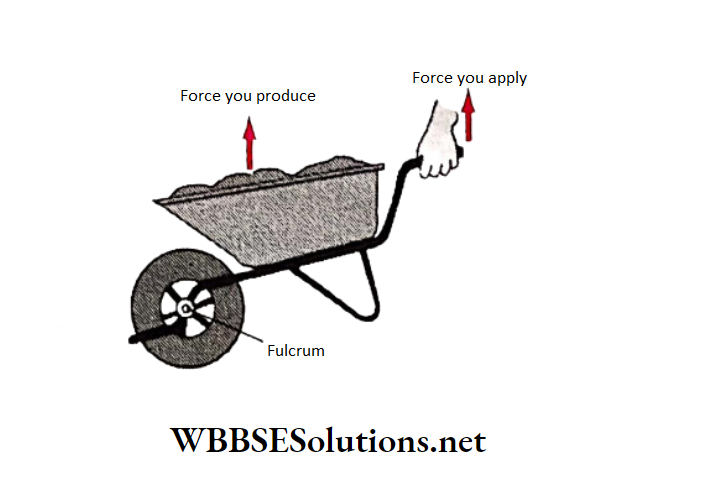
Third-class or Class-3 levers
A Third class lever, like a Second class lever, has the fulcrum at one end.
But the two forces switch around. Hence the effort or force is applied at the middle and the force is produced at the opposite end. Thus the effort is placed between the fulcrum and the load.
Third Class levers reduce the force you apply, giving you much greater control. Stapler, fishing
rod and tongs are examples of Third Yowlega pro-class levers.
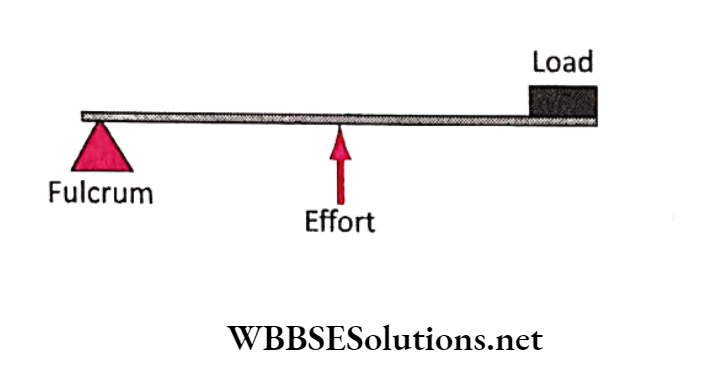
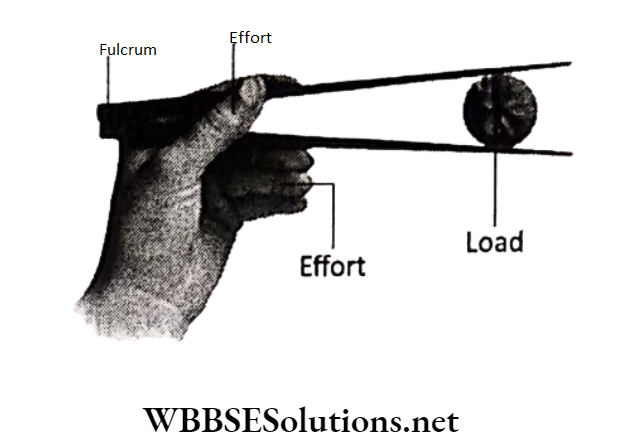
Question 4. What is an inclined plane? How is it useful?
Answer:
Inclined Plane
The inclined plane is simply a ramp whose one end is higher than the opposite end. This allows things to go from a low place to a higher place without much effort.
But the load has to be moved over a longer distance as compared to pulling it up vertically. Whether the inclined plane is long or short, the amount of work done shall be the same.
Thus an inclined plane does not decrease work but makes it easier. On the other hand, gravity makes it easier to move an object down a ramp than up that ramp.
A slide in the children’s park, a d-leaning ladder, a staircase, and a sloping wooden plank (Fig. 9.22) are examples of inclined planes.
The acute angle that the inclined plane makes with the ground is called the angle of incline (Fig. 9.23) or slope.
If the slope of the inclined plane is low meaning that a smaller angle between the ground and the plane, then it is easier to climb up.
The mechanical advantage of an inclined. the plane is linked to the slope or angle of the incline.

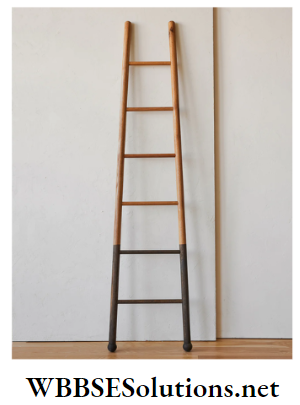
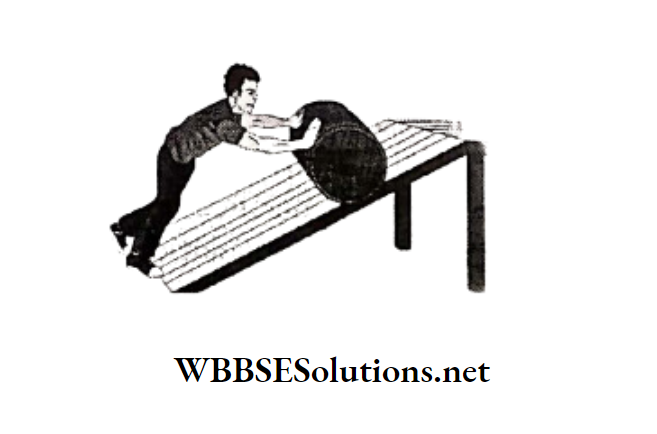
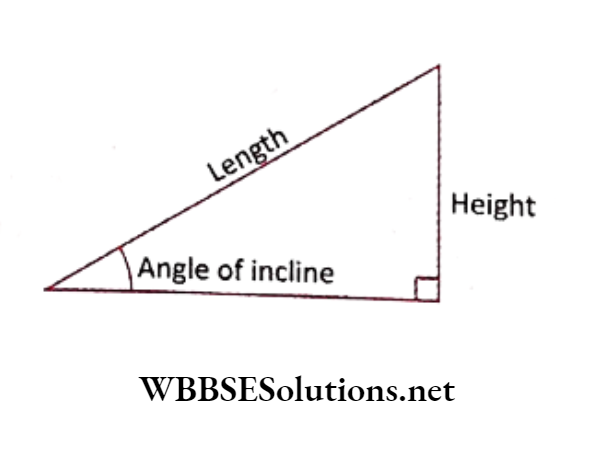
The mechanical advantage \(=\frac{\text { Length }}{\text { Height }}\)
It is apparent that the length of the inclined plane is greater than its height. Hence, by applying a small effort, the big load may be raised. The inclined plane has a mechanical advantage always greater than 1.
Uses of the inclined plane
- As loading ramps to load and unload goods on trucks, ships, planes, etc. FEAR
- As wheelchair ramps for aged, invalid persons and patients.
- As staircase and escalators.
- As conveyor belts.
Question 5. What is a pulley? How is a fixed pulley different from a movable pulley? Explain with diagrams.
Answer:
The Pulley
The pulley is actually a modified version of a wheel and axle that is combined with a rope, chain or other cord passing through a groove to allow moving something up and down or back and forth.
The rod that passes through the center of the pulley is called the axle. The pulley rotates freely about the axle.
The pulley can be combined with other pulleys to reduce the amount of work necessary to lift huge amounts of weight or to lower them down.

It can also make moving something such as a flag up the pole convenient to do from the ground. It changes the direction of the applied force necessary to do the work.
You pull down on the rope, but the flag goes up. Pulleys are used in window blinds and drapery to move them up and down or back and forth.
Pulleys are also used on ships to raise and lower sails, in the industry to raise and lower heavy cargo, or on cranes for use in moving construction equipment.
Elevators also use pulleys to move the car up and unban down from floor to floor.
There are three types of pulleys-fixed, movable, and compound. A fixed pulley is fastened to some support by means of a hook.
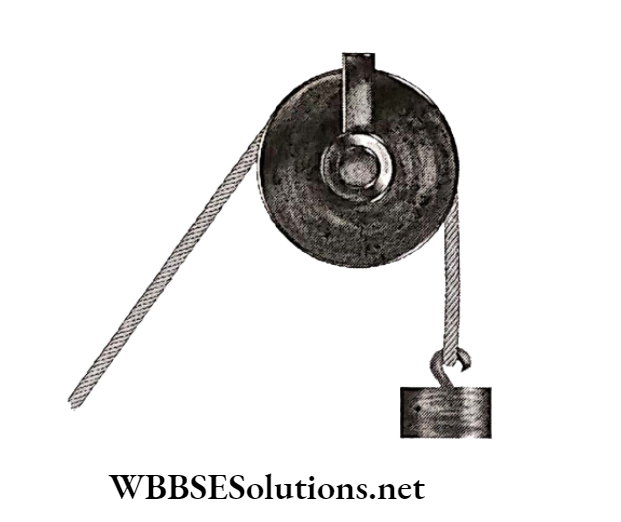
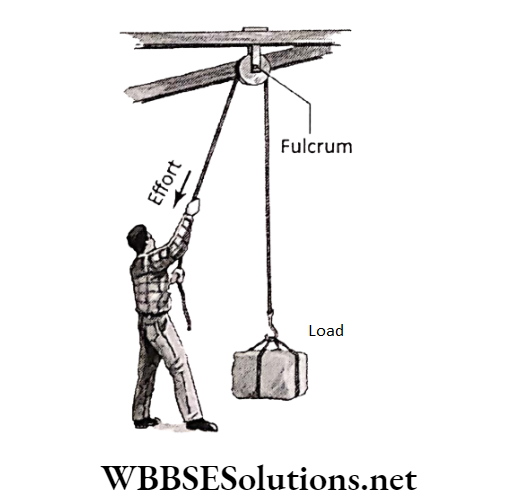
Real-Life Scenarios Involving Inclined Planes and Wedges
A very common use of a single fixed pulley is in lifting water from wells. A movable pulley is one that remains fastened to the load itself. This type of pulley is free to move up and down.
Examples of movable pulleys include construction cranes, modern elevators, and some types of weight-lifting machines at the gym.
The third type of pulley is the compound pulley, which consists of combinations of fixed and movable pulleys.
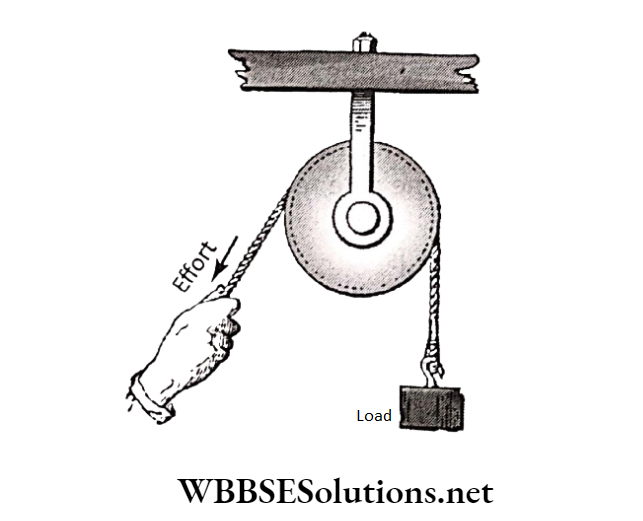
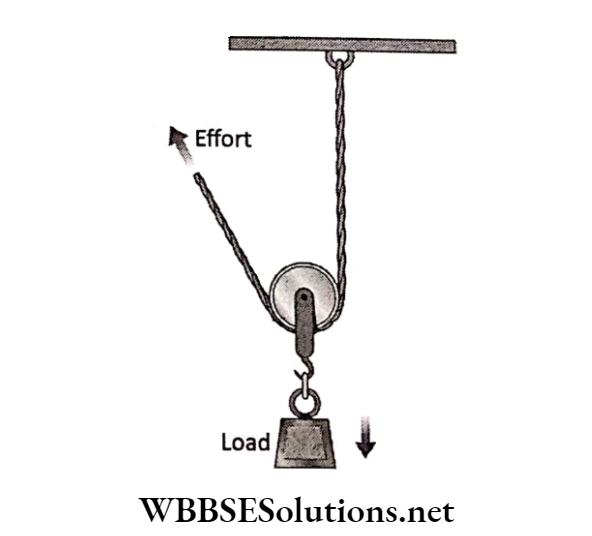
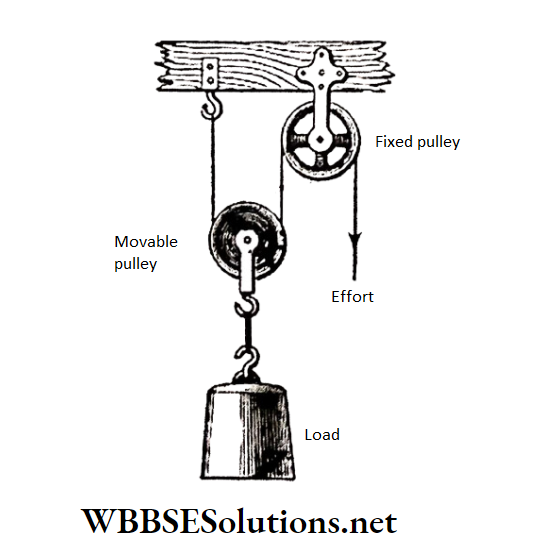
Conceptual Questions on the Functionality of Simple Machines
Question 6. Why do machines require maintenance? Elaborate a few simple steps to follow for the maintenance of machines.
Answer:
Maintenance Of Machines
Machines undergo wear and tear as they are put to use on a regular basis.
If not taken care of properly, this may lead to permanent damage to the component parts, discoloration or rusting, malfunctioning, decreased efficiency, and above all, serious danger to the person operating the machine.
Hence regular upkeep and maintenance on the overall functionality and condition of machines are a must to keep the continuity of what is expected and the standard performance of the machines.
Simple steps to follow for maintenance of machines :
1. Keep it routine:
Just like the annual check-up with a physician, a regular check-up has to be made to inspect the conditions of the parts of a machine in order to ensure desired performance it.
This is an absolute emergency for heavy and complex machines.
2. Cleaning:
Routine cleaning after every use increases the longevity and performance of a machine many times.
3. Lubrication:
Lubrication of moving parts using grease or oil is an important part of regular machine maintenance. The lubrication procedure may be repeated in line with the degree of usage.
4. Rust prevention:
Metallic parts of a machine shall be protected from rusting caused by moisture ingress by suitably applying an anti-rust synthetic enamel paint or oil paint.
5. Don’t overwork the machine:
It is always advisable that the stated performance of a machine should not be exceeded at any point in time.
Overwork leads to greater wear and tear and finally to the shorter life span of the machine under consideration.
Question 7. The sewing machine is a complex machine- explain.
Answer: A sewing machine has several parts such as the main driving wheel, small driving wheel, needle, foot pedal, etc. which are made up of many simple machines such as wheel and axle, wedge, lever, and screw.
The main driving wheel and the small driving wheel work on the basis of wheel and axle. A sewing machine’s needle works on the basis of the wedge. The foot pedal works on the basis of the lever.
Also, a sewing machine employs a number of screws which play a vital role in its functioning. Thus it is a complex machine made up of many simple machines.
Question 8. Compare a single fixed pulley with a single movable pulley.
Answer: Comparison of the single fixed pulley and single movable pulley

Question 9. Explain what is meant by the Two ramps shown in the figure. Which ramp would be more convenient to use to move a heavy barrel up into a truck?
1. mechanical advantage 1
2. mechanical advantage > 1 and
3. mechanical advantage <1 for a simple lever.
Answer:
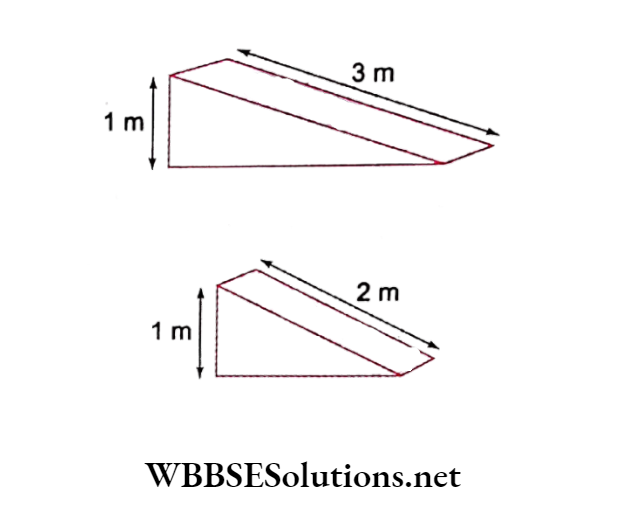
⇒ \(\text { mechanical advantage }(M A)=\frac{\text { Load }}{\text { Effort or Input force }}\)
If MA=1, the input force to be applied to the lever has to be the same as the load.
If MA>1, less input force needs to be applied to the lever compared to the load to be driven. Thus the work becomes easier.
If MA<1, more or greater magnitude of input force is required to be put into the lever to drive the load.
Ramp (a) has a more mechanical advantage compared to ramp (b) since for the same height, the length of the slant surface of ramp (a) is more than that of ramp (b).
Thus for some elevation changes, the distance to be traveled horizontally is more in the case of ramp (a). Thus the effort or force needed to push the barrel up is lesser in the case of ramp (a).
